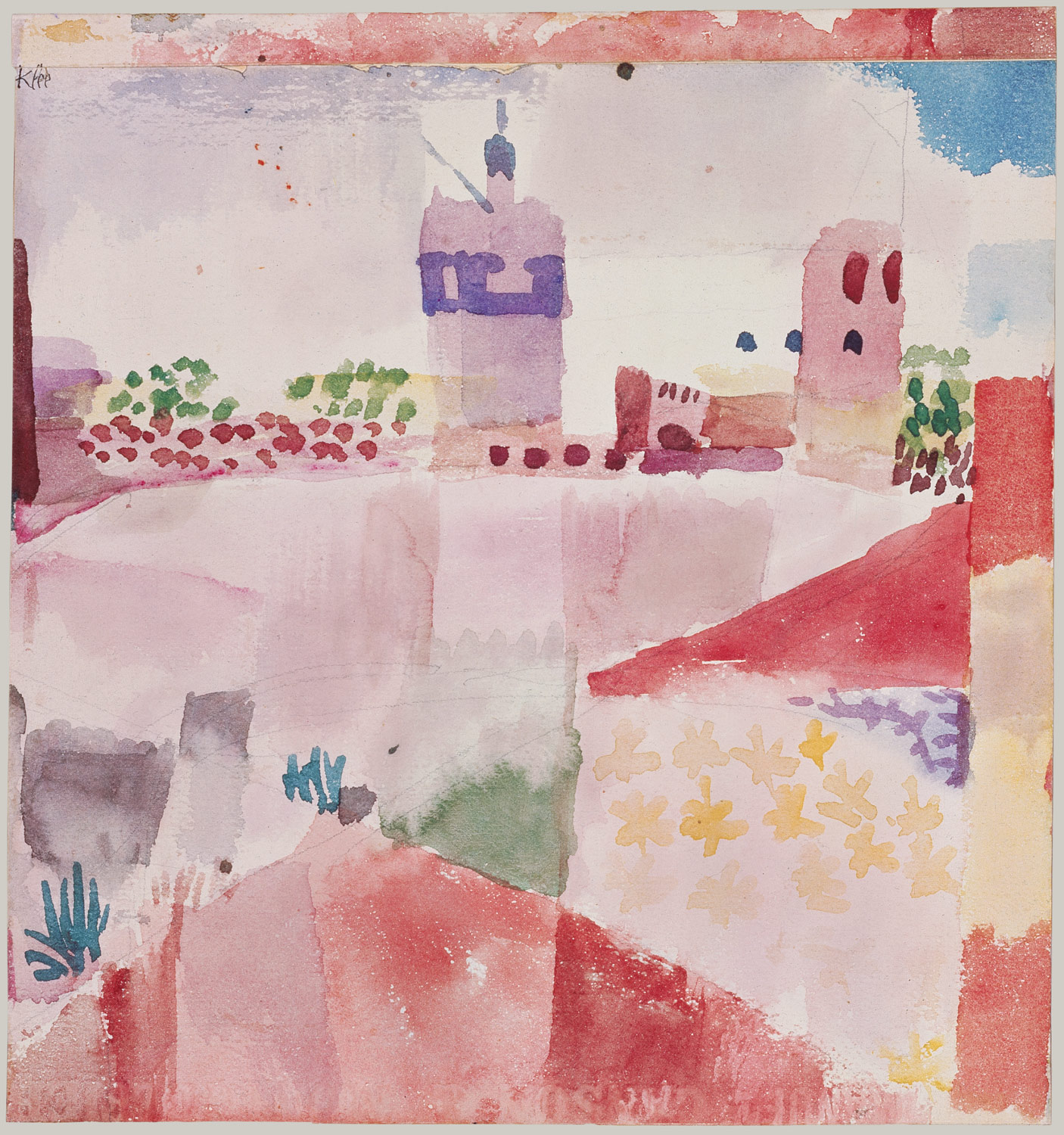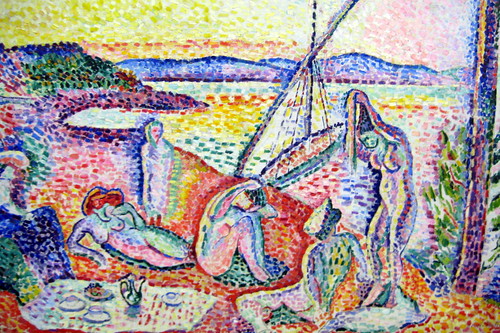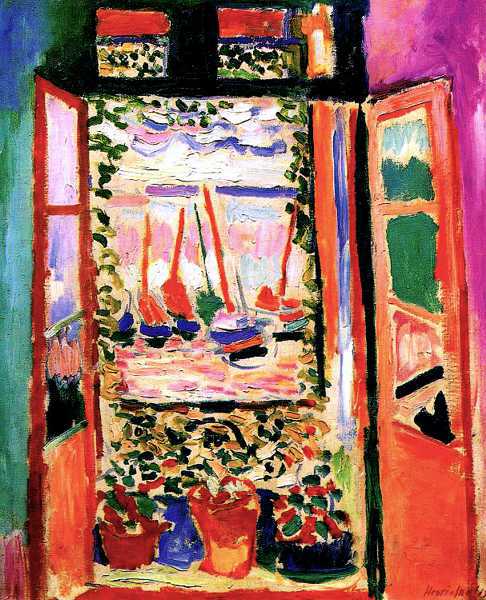At first glance, the freedom in Matisse's style in Open Window seems to deny any skill or technique. Only upon further analyzation does it become obvious how effective his use of visual elements is and an instinctive sensibility becomes visible. The key to making this painting work visually is the simplification of forms that allow for the use of such exaggerated colors. Matisse realized that if he intensified the color, he had to also reduce the amount of detail in order to achieve the expressive effect he aimed for. He had this to say on the subject:
"We move towards serenity through the simplification of ideas and form.......Details lessen the purity of lines, they harm the emotional intensity, and we choose to reject them. It is a question of learning - and perhaps relearning the 'handwriting' of lines. The aim of painting is not to reflect history, because this can be found in books. We have a higher conception. Through it, the artist expresses his inner vision."When first displayed in the Salon d'Automne in 1903, Open Window was ridiculed and hated by critics and public alike. Eyewitness accounts tell of laughter coming form Room VII where it was being exhibited. Critic Louis Vauxcelles disparaged the painters, quipping:
"Tiens, Donatello chez les fauves" (Well, well, Donatello among the wild beasts)Henri Rousseau's large jungle scene The Hungry Lion Throws Itself on the Antelope was exhibited near Matisse's work and may have had an influence on the pejorative used. Regardless, the name stuck and the movement, led by Matisse, became known as Fauvism. Room VII thereafter became known as "le cage." Matisse, disheartened by the bad reception of his works, found comfort in Gertrude and Leo Stein after their purchase of Woman in a Hat. The two also introduced him to Pablo Picasso, with whom Matisse worked increasingly with and against for the rest of his career. Matisse told Gertrude Stein that he and Picasso were "as different as the north pole is from the south pole." Art historian John Richardson commented on the this quote and the relationship between the two artists:
"although the North and South Poles are antitheses, the icescapes surrounding them are indistinguishable. Matisse apparently wanted to emphasize that, while he was very much a man of northern France, Picasso was very much a man of southern Spain. Indeed, there seems to have been a magnetic pull between them, a yin-yang polarity that allowed for a constant shift in the roles of giver and taker, leader and follower, hero and antihero."
 Richardson goes on to call the two "opposing deities: Matisse as Apollo and Picasso as Dionysus." The to artists traded paintings within a year of meeting each other. Trying to dramatize the rivalry between them, Stein said they both chose “the picture that was undoubtedly the least interesting either of them had done. Later each one used it as an example … of the weaknesses of the other one.… The strong qualities of each painter were not much in evidence.” Instead the to chose paintings that they wished to learn from. Matisse chose "a Picasso still life, a tight, tough, awkward little painting of a lemon and some ugly nondescript objects which tease the beholder’s eye with their convexities and concavities." He did so with intentions to revolutionize the genre of still life painting, something both Cezanne and Picasso had attempted. Picasso's painting challenged Matisse to take risks he had not contemplated prior. Picasso told one of his biographers, Pierre Daix, “You have got to be able to picture side by side everything Matisse and I were doing at that time. No one has ever looked at Matisse’s painting more carefully than I; and no one has looked at mine more carefully than he.” The two pushed each others boundaries and kept each other's ideas relevant and new. Their friendship and rivalry is one of the most peculiar yet astounding in the art world. It would be interesting to see what would have become of the two had they not met and influenced one another so greatly.
Richardson goes on to call the two "opposing deities: Matisse as Apollo and Picasso as Dionysus." The to artists traded paintings within a year of meeting each other. Trying to dramatize the rivalry between them, Stein said they both chose “the picture that was undoubtedly the least interesting either of them had done. Later each one used it as an example … of the weaknesses of the other one.… The strong qualities of each painter were not much in evidence.” Instead the to chose paintings that they wished to learn from. Matisse chose "a Picasso still life, a tight, tough, awkward little painting of a lemon and some ugly nondescript objects which tease the beholder’s eye with their convexities and concavities." He did so with intentions to revolutionize the genre of still life painting, something both Cezanne and Picasso had attempted. Picasso's painting challenged Matisse to take risks he had not contemplated prior. Picasso told one of his biographers, Pierre Daix, “You have got to be able to picture side by side everything Matisse and I were doing at that time. No one has ever looked at Matisse’s painting more carefully than I; and no one has looked at mine more carefully than he.” The two pushed each others boundaries and kept each other's ideas relevant and new. Their friendship and rivalry is one of the most peculiar yet astounding in the art world. It would be interesting to see what would have become of the two had they not met and influenced one another so greatly.Sources:
http://www.vanityfair.com/style/features/2003/02/picasso-matisse200302
http://www.artyfactory.com/art_appreciation/art_movements/fauvism.htm
http://en.wikipedia.org/wiki/Salon_d%27Automne
http://www.nytimes.com/2006/07/14/arts/design/14rous.html?_r=1&oref=slogin&pagewanted=print








.jpg)



















.jpg)



 La Grande Jatte.
La Grande Jatte.
 The Open Window (1905), also by Matisse. Compared to Edvard Munch's The Scream.
The Open Window (1905), also by Matisse. Compared to Edvard Munch's The Scream.



